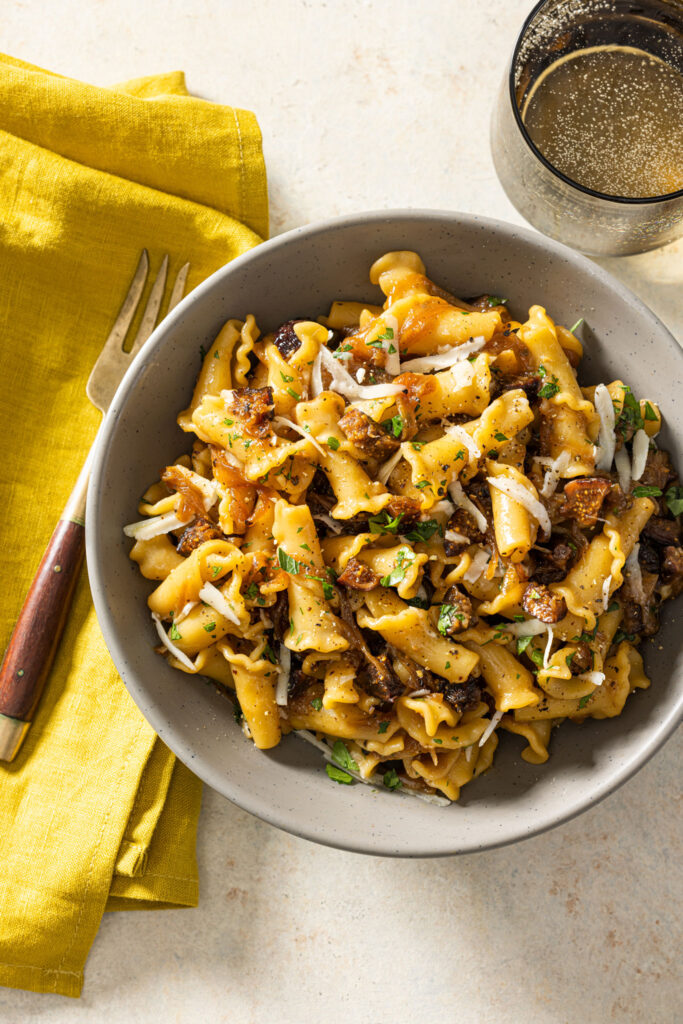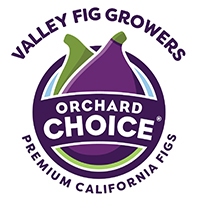Introducing Orchard Choice Fig Balsamic Vinegar!
Fig Balsamic Vinegar, created in the tradition of the Mediterranean, blends robust Italian red wine vinegar with dried California figs that have been hand-picked at their peak of sweetness. An aromatic fruity vinegar with a delicately balanced sweet-tart flavor, Blue Ribbon Orchard Choice Fig Balsamic Vinegar brings out the best in grilled vegetables; adds complexity and allure to sauces, marinades and salad dressings; and delivers a simple, elegant finish to fish, poultry, and red meats.
Orchard Choice Fig Balsamic Vinegar is now available online at our Growers Store. Try our vinaigrette recipe on your favorite green salad, sliced tomatoes, or on whole grain pasta and fresh vegetable salad for a delicious summer dish. Newly released studies support the value of a Mediterranean-style diet and Blue Ribbon Orchard Choice Balsamic Vinegar is a great start.
Fig Balsamic Vinaigrette
- 1/2 cup Orchard Choice Fig Balsamic Vinegar
- 2 tablespoons honey
- 2 cloves garlic, minced
- 1 1/2 teaspoons Dijon mustard
- 3/4 cup extra virgin olive oil
- Fresh or dried thyme to taste, if desired
- Salt and pepper to taste
- Wisk all ingredients together.
On the Nutrition Front
By Cherryl Bell, RD, MS
- As reported in Environmental Nutrition, a Boston study of 50 men and women, average age 71, confirmed that diet and exercise can help prevent stroke. Intakes of both total fiber and insoluble fiber were inversely linked to stroke severity. The average fiber intake in the study was only 10 grams a day, which is less than half the Daily Value of 25 grams. This is great news for figs and consumers. Figs taste great and contain 5 grams of dietary fiber in each quarter cup (about 3-5 figs). And, figs contain both soluble and insoluble fiber. Source: Environmental Nutrition, May 2008.
- It’s always nice to see independent experts confirming what we already know. In a recent issue of Environmental Nutrition, 12 common food additives were rated as Safe or Sorry Ingredients. Under the heading of Worry-Free Additives, Environmental Nutrition listed Potassium Sorbate. “A preservative/mold inhibitor found in foods and drinks like wine, cheese, yogurt and dried meat.” Potassium sorbate is used in dried California figs for this exact reason and is listed in the ingredient list of conventional Orchard Choice and Sun-Maid Figs. Source: Environmental Nutrition, May 2008.
- Food Label Fact. Currently the Nutrition Facts panel lists total sugars, which could come either from natural sources or added sugars, but the labels do not make a distinction between the two. Is there a way to figure out how much “added sugar” is in a product? A U.S. Department of Ag online table shows the added sugars, total sugars and carbohydrates in more than 2,000 common foods. The data are estimated values based on the added sweeteners listed under “ingredients” of processed food and beverages. Some added sugars include honey, molasses, fruit juice concentrate, brown sugar, corn sweetener, sucrose, lactose, glucose, high-fructose corn syrup and malt syrup. According to 1999-2002 US survey data, consumers eat about 74 pounds of added sugars per year. The 2005 Dietary Guidelines for Americans emphasize the importance of eating nutrient-dense foods as well as choosing and preparing foods with little added sugars. While food containing natural sugars such as fruit and milk are rich in vitamins and minerals, many foods and beverages that contain added sugars are devoid of beneficial nutrients. Check out the Orchard Choice and Sun-Maid labels; you will see the delicious sweet taste of Mission and Calimyrna figs is all natural, no added sugars. Next time you’re looking for a sweet snack or something sweet for your cereal, grab some figs. Source: ADA Times, 2008.
Too Hot to Cook
Try Flank Steak Ribbons with Fig Pear Salad
When it’s too hot to cook in the house, the barbecue grill offers a great solution. One of our newest recipes can be served as a small plate appetizer or as a main dish. Here are some behind the scenes tips from our test kitchen experts.
The salad is beautiful with any pears, but especially red Anjou. For the greens, we really like arugula and baby greens. Radicchio is nice for color if red pears are not available. A non-alcoholic option for the wine would be orange juice. We love the extra crunch of nuts; some Marcona almonds are delicious with this combo. You can put the rub on the steak, cover and chill for several hours if desired. The recipe makes about 4 cups of salad or 8 (1/2 cup) servings or 12 (1/3 cup) servings. You can also turn it into a light main dish and make 4 servings. Nutrients per serving (8): Calories 336 (46% calories from fat); Protein 19 g; Total Fat 17 g (Saturated Fat 4 g, Trans fat 0 g); Carbohydrate 24 g; Alcohol 1.5 g; Calcium 85 mg; Cholesterol 37 mg; Dietary Fiber 4 g; Sodium 530 mg.
Fig Puree — A Fat Substitute
We’ve received several requests lately for a fig puree recipe to use as a fat replacement in baked goods. Here is a recipe from the folks at the California Fig Advisory Board. Keep in mind, when replacing fat in baked goods, it’s best to only replace a small amount of the fat. Fat not only flavors baked goods, but plays an important role in the texture as well. Fruit purees as fat replacements work best in moist, soft and chewy baked goods—not crispy. A general rule of thumb is: omit half the fat, and replace it with half the amount of fig puree. So, if a recipe calls for 1 cup butter, you would omit 1/2 cup butter and replace it with 1/4 cup fig puree. Be careful not to overmix the batter and you may want to reduce the sugar called for in the recipe by about one-third.
Fig Puree
- 2 cups dried California figs
- 3/4 cup water
- 2 teaspoons vanilla
In the bowl of a food processor, combine all ingredients. Process until smooth. Makes about 1 1/2 cups.
Back to School Lunch Ideas
Packing lunch every day and keeping the foods healthy is no easy task. Aim to include fruits, vegetables, whole grains and protein. For example, offer a turkey sandwich on whole grain bread made with lettuce, sliced red onions, avocado, mustard and provolone cheese; some carrot and celery sticks or sugar snap peas; nonfat milk, and some sweet, chewy figs or better yet a fig bar. Ask your kids to come up with some ideas and have them help pack lunch the night before. Suggest they go to the grocery store with you or give you a list. The more input they have, the more likely they are to eat lunch, instead of trading it away. Talk about healthy choices and think of creative ways to make lunch fun and tasty. We highly recommend the Fabulous Fig Bars found in our recipe dessert section. Make these bars with orange juice and they’re sure to be a big hit with the kids.
Come Celebrate the 5th Annual Fresno Fig Fest!

Cooking Demonstrations, Gourmet Food Samples, Fresh & Dried Figs, Amazing Recipes & More!
$5 Admission>
August 9th
9:00 AM – NOON
Location: Fresno State Campus between the Ag Science Building and the Satellite Student Union. Near the corner of Barstow & Maple Avenues
Summer In the Fig Orchards
Summer is finally upon us. The next few months will be quite busy for Valley Fig Growers members. The pollination (caprification) of the Calimyrna fig crop was completed successfully in June and the fruit is maturing nicely.
June is the beginning of the fresh fig harvest as first crop Mission figs are harvested through the month of June. The main crop of fresh Calimyrna figs is harvested in the first half of August. Fresh Mission and Kadota figs are harvested from mid-August through September. Brown Turkey fresh figs (there is no commercial production of dried Brown Turkey figs) are ready to pick about the first of September and harvest will continue through November if the weather allows.
The dried fig harvest will begin early August and continue until about the first of October. Growers harvest the dried figs and transport them to their sorting sheds or commercial sorting operators for the removal of defective figs and extraneous materials prior to delivery to Valley Fig Growers. Throughout the final growing season growers will be tending to their orchards to ensure that the trees have adequate water during the hottest part of the summer. Temperatures in the San Joaquin Valley are typically in the 100s range during July, August, and much of September.
This year looks to be a very good year for Valley Fig Growers.




